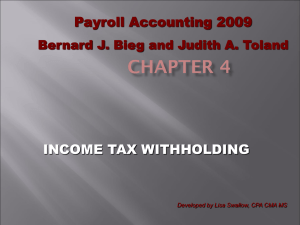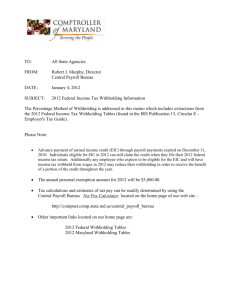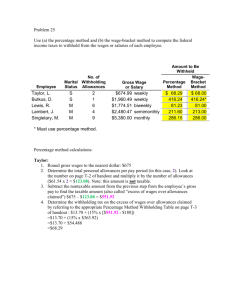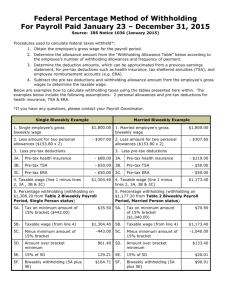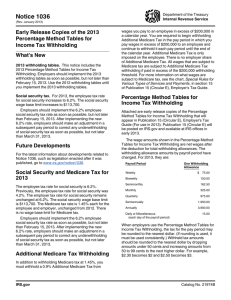Chapter 4
advertisement
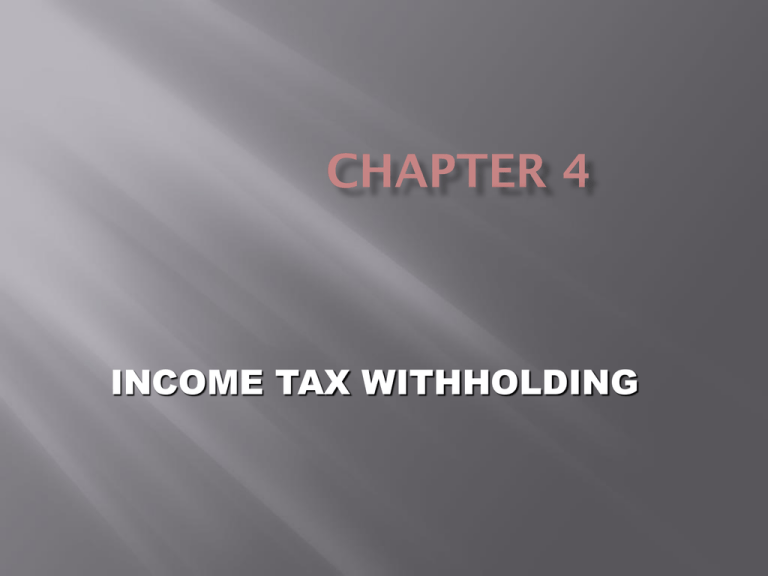
INCOME TAX WITHHOLDING Coverage Under Federal Income Tax (FIT) Withholding Laws EE-ER relationship must exist See Chapter 3 for how to determine status Statutory nonemployees (direct sellers and qualified real estate agents) have no federal taxes withheld Taxable Wages for FIT withholding purposes Wages/Salaries Vacation Supplemental wages Bonuses Taxable fringe Tips Cash awards Noncash fringe benefits treated as compensation ER must withhold FIT unless specifically excluded Examples include Tickets to athletic events Athletic club membership Personal use of corporate car Frequent flier miles Stock options (when option exercised) Complete list found in Figure 4-1 (page 4-3) Specifically excluded fringe benefits include De minimis and working condition fringe Reduced tuition, qualified transportation fringes, meals & lodging if for ER benefit Complete list found on page 4-6 Value and withhold like supplemental wages (flat 25%) ER must figure value of fringe benefits no later than 1/31 Also a special period rule that uses 10/31 as cutoff date Value and add to regular pay - treat as one paycheck and withhold accordingly Flexible reporting - can add $500 on 4 paychecks or entire $2,000 with one paycheck and withhold, for example Employee must report tips to ER by 10th of each month Employer must withhold FIT and FICA based on this information (called “reported tips”) Employer is not required to withhold on allocated tips (see chapter 3) - only reported tips Tip allocation can be done one of three methods What if taxes withheld > hourly wages to be paid? For example blackjack dealer reported tips = $2,000 for one week; her FIT/FICA withholding will exceed her paycheck EE gets no paycheck and pays quarterly estimated tax payments or Can pay balance of tax with 1040 tax return Travel reimbursements but only if made under an “accountable plan” An accountable plan is an IRS-approved plan If there is not a plan in place, travel reimbursements are made under a non-accountable plan and considered wages Therefore ER must withhold FIT Law excludes certain payments including: Ministers’ wages/salaries Advances Educational assistance If maintains/improves job status $5,250 per year of employer provided assistance for undergraduate or graduate is tax-free Qualified moving expense reimbursements See page 4-6 for comprehensive list of exemptions Contribution to flex plans or cafeteria plans (known as Section 125 plans) These are salary reductions whereby EE puts pretax dollars into a trust account to be used for health care, certain insurance premiums and dependent care These dollars do not have FIT or FICA withheld on them Health Savings Accounts (HSA) If EE has high-deductible health insurance, can contribute annually to an HSA pretax to meet out of pocket medical bills Archer Medical Savings Accounts apply to small employers (50 or fewer employees) Contributions to tax-deferred retirement accounts Types of retirement plans 401(k), 403(b), 457 or SIMPLE plans Contributions are made pretax for FIT purposes However, ER must still withhold and match FICA Additional ‘make up amounts’ allowed to be contributed if over 50 years old Individual Retirement Accounts [IRAs] For certain taxpayers, the lesser of $5000 or 100% of earned income may be contributed pretax to a retirement account Conditions must be met for deductibility Roth IRAs accommodate nondeductible contributions Best for EE if FIT withholding = tax liability (goal is no refund and no tax due) Employee completes W-4 S See Figure 4-3 Employee’s Withholding Allowance Certificate Identify number of withholding allowances One allowance for self (if not claimed by other person) One for each dependent Special allowances such as itemized deductions, other compensation, tax credits, etc. Use worksheet on back of W-4 to calculate Choose “Single” or “Married” or “Married, but withhold at higher single rate” box Why would an EE choose the option listed above? (line 3) Because possibly other sources of taxable income Exempt status Can claim if taxpayer had no income tax liability last year and none expected this year (line 7) Valid for one year and must be reclaimed each year Can’t claim exempt if: Dependent on someone else’s tax return and Income exceeds $900 (including more than $300 unearned income) Some individuals are automatically exempt *Note: Never advise employee as to how many allowances to claim If EE doesn’t provide a completed W-4, ER withholds as if single and 0 (highest rate) EE can change W-4 When ER receives amended W-4, has 30 days to change EE must change within 10 days for decrease in # of allowances Lose child as an allowance (custody) Become single If there’s an increase in # of allowances, can change or leave in effect Unauthorized changes/additions invalidate W-4 Employers are not required to verify authenticity If form is altered, ER cannot accept invalid form Can then ask for new W-4 to be submitted Or, if a new hire, withhold at “single and 0” rates Pensions (W-4P) in excess of $19,000 per year Withhold as if married with 3 allowances unless complete W-4P to change amount of tax withholding Third party payer of sick pay (W-4S) Government payments such as Social Security (W-4V) – this request is voluntary Use either wage-bracket method (easiest) or Percentage method (only use if one of the following apply) Highly compensated or 10+ allowances or Compensated annually, semiannually or daily Need to know Single/married How often paid Gross pay Number of allowances Or can use quarterly averaging, annualizing wages or part-year employment method (rarely used) FACTS: Annual salary is $40,144 - paid weekly – Married 4 - what is FIT withholding? Weekly gross $40,144/52 = $772.00 Can use wage bracket tables to look up married, weekly and 4 allowances FIT withholding = $38 FACTS: Annual salary is $84,400 – paid semimonthly – Married 1 - what is FIT withholding? Semimonthly gross is $84,400/24 = $3,516.67 Must use percentage method To Do: Subtract (# of allowances x amount for each allowance) from gross: $3,516.67 - (1 x $145.83) = $3,370.84 FIT equals $368.55 + (.25)($3,370.84 – 3,006.00) = $459.76 FACTS: Monthly salary is $3,000 - paid semimonthly – Single 2 - what is FIT withholding? Annualize salary $3,000 x 12 = $36,000 Semimonthly gross $36,000/24 = $1,500 Can use wage bracket tables to look up single, semimonthly and 2 allowances FIT withholding = $150 FACTS: Annual salary is $336,000 - paid monthly Single 2 - what is FIT withholding? Monthly gross is $336,000/12 = $28,000 Must use percentage method To Do: Subtract (# of allowances x amount for each allowance) from gross: $28,000 - (2 x 291.67) = $27,416.66 FIT equals $3735.45 + (.33)(27,416.66 -17,308.00) = $7,071.31 FACTS: Annual salary is $485,000 - paid semimonthly - Married 4 - what is FIT withholding? Semimonthly gross is $485,000/24 = $20,208.33 Must use percentage method To Do: Subtract (# of allowances x amount for each allowance) from gross: 20,208.33 - (4 x 145.83) = $19,625.01 FIT equals $4,032.32 + (.35)(19,625.01 – 15,213.00) = $5,576.52 Examples include: Vacation Pay (treated differently than other supplemental wages) Severance pay, bonuses and commissions Exercised nonqualified stock options Retroactive increases How to withhold With regular pay (treat as one paycheck and withhold accordingly) Paid Separately Method A – Add supplemental and regular wages from recent payroll. Calculate FIT and then subtract tax withheld from regular wages. Method B - 25% flat supplemental withholding (35% for amounts in excess of $1,000,000) If want to give $700 bonus check (net), employer must ‘gross up’ this amount Divide net check by total of [1.00 – tax rates] FIT = .25 OASDI = .062 HI = .0145 $700/[1.0 – (.25 + .062 + .0145)] = $1039.35 grossed up bonus less taxes = $700 net bonus Note: in many states there is a required withholding rate for state income tax! Earned income credit [EIC] is intended to offset living expenses for eligible employees To get advanced EIC on each paycheck, file Form W-5 Can only get advanced earned income credit if have at least one qualifying child Can get up to $4,824/year with 2 qualifying children Advanced EIC does not change amount employers must withhold from wages Sometimes EIC payments exceeds withheld taxes – employer can handle one of two ways Reduce each advance EIC payment proportionately or Fully pay and treat as advance payment of company’s employment payroll taxes EE may only have one certificate on file at a time If married, both spouses can have certificate Have to file a new certificate each year Have to revoke in 10 days if ineligible On Form 941 advanced EIC shows up as a reduction from total taxes to calculate net taxes due for quarter Advanced EIC is treated as having been paid to the IRS Form W-2 Hard copy to EE by 1/31 or Can post on secure web site so EE can access individual W-2) Send to SSA by 2/28 If issuing 250+ W-2s must use magnetic media and have until 3/31 to electronically file Can request extension of time via FIRE at http://fire.irs.gov W-3 is transmittal form 941s must tie to W-3 Various penalties for filing incorrect or late W-2s W-2c and W-3c (if correcting) Employers must file information returns for compensation paid to independent contractors (IC) 1099-MISC with 1096 as transmittal See Figure 4-16 (page 4-33) Must issue to IC paid over $600 that aren’t incorporated Backup IC withholding must submit taxpayer identification number (TIN) on W-9 If W-9 not on file, hiring agent must withhold federal income tax = 28% of payments made In states with state income tax and localities with local income tax, generally the payroll department must File periodic withholding returns - report wages and withholding Prepare reconciliation returns – compare deposits to withholdings File annual statements – annual wages paid and state tax withheld Issue information returns – used to report payments to individuals not subject to withholding Three different methods of withholding *Note: all but nine states have a state income tax
